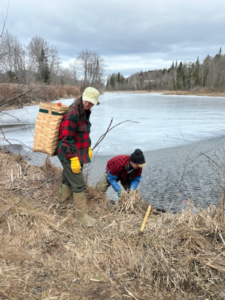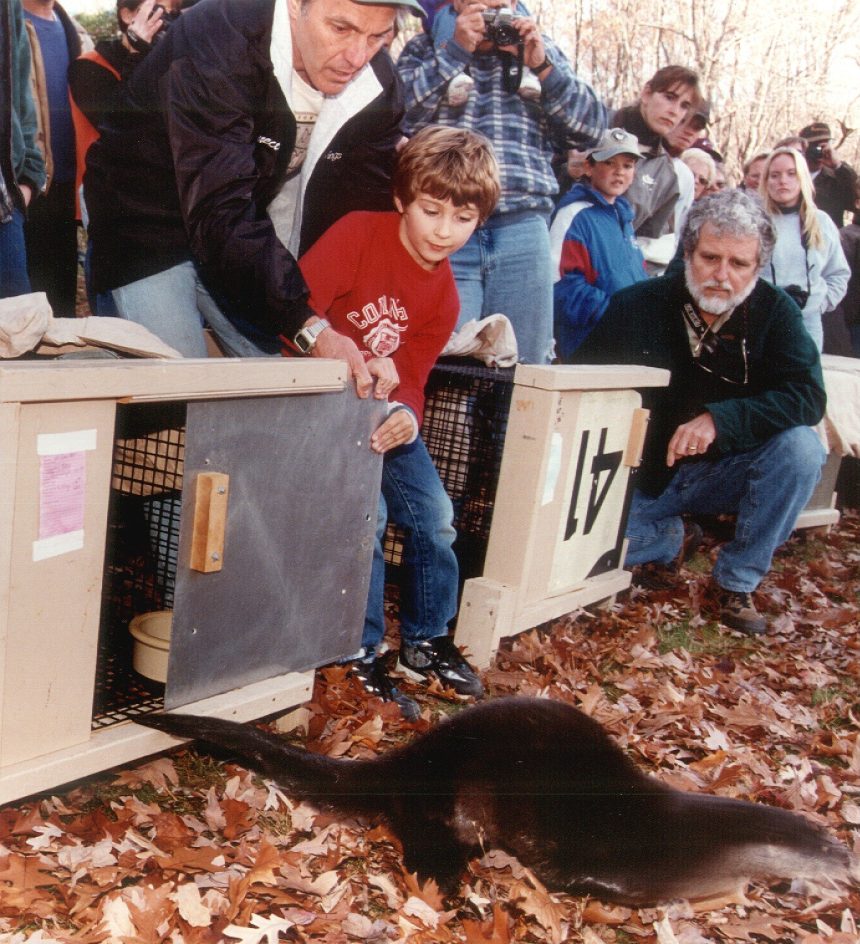By Cindy Sandoval, USFWS
As night falls on American waterways the water suddenly stirs. A whiskered head emerges, followed by a sleek, brown body that slips through the current. The North American river otter is back.
Once a familiar sight across America’s waterways, river otters dwindled across much of their native range by the mid-20th century. The culprits were all too common: pollution, unregulated harvest, and rapid habitat loss. Streams once teeming with life turned silent. But today, cleaner waterways, conservation professionals supported by Pittman-Robertson funds, and an evolving understanding of resource management has allowed river otters to reclaim their place in ecosystems.
New York’s River Otter Comeback
Otters were once found in every watershed in New York. But by the early 1900s, they had vanished from western parts of the state and metropolitan areas. Luckily, populations of river otter remained in remote and isolated areas. Nearly 100 years later these remote populations would take part in the revival of the river otter.
From 1995 to 2001, the New York State Department of Environmental Conservation (DEC) embarked on an ambitious mission to restore the river otter to its former haunts. Working with licensed trappers, 279 otters were relocated from strongholds in northern New York to 16 sites in central and western regions of New York. “Most of the river otters in the restoration effort were trapped in the Adirondacks and other parts of Northern NY, with a handful being trapped in the Catskills and Hudson Valley for relocation,” said DEC furbearer biologist Mandy Watson.
In New York, and across North America, licensed trappers have been a vital partner when state fish and wildlife agencies need trapping expertise to relocate or reintroduce furbearer species like fisher and river otter. “Since trapping otters requires significant skill, we could not have done it without the assistance of experienced trappers who contributed their time to attempt to trap otters for the reintroduction effort,” adds Watson.
The reintroduction of otters was not just catch and release, it required years of work, involving carefully monitored releases, and extensive follow-up. Since restoration, DEC staff have spent years conducting meticulous winter sign surveys—tracking footprints, slide marks, and scat across snow-covered streambanks. With analytical support from SUNY-ESF, the surveys paint a hopeful picture. Otters were not just surviving, they were thriving. In fact, the restored population in western New York has nearly saturated all available habitat.
A Nationwide Effort, Funded by Manufacturer Federal Excise Tax
New York wasn’t alone. More than two dozen states recognized the ecological role of the river otter and launched similar restoration efforts. From Colorado’s alpine rivers to the cold-water New England creeks, otters made a comeback. “This restoration success would not have happened without Pittman-Robertson funds,” said Chris Dwyer, a wildlife biologist with the U.S. Fish and Wildlife Service. “These federal excise tax dollars, matched with state trapping and hunting license funds, supported state fish and wildlife agency staff time, research, and relocation work making river otter recovery possible nationwide.” Since 1937, federal excise taxes paid by the manufacturers of firearms, ammunition, and archery gear have funded wildlife conservation. It’s a model of conservation success—and one that’s paid off with river otters now found in all of the contiguous United States and Alaska.
More Than a Comeback—A Restoration Blueprint
There are 13 species of otters in the world. Twelve of them are considered vulnerable, threatened, or endangered. Only one species, the North American river otter, is bucking the trend.
“The river otter are a conservation success story,” said Nathan Roberts, Professor of Conservation and Wildlife Management at the College of the Ozarks. “Their populations have been restored across the country, and we have the capable and competent management programs to ensure that they are going to be around for the long-term.” According to Roberts part of the success of this restoration, and what sets the river otter apart from other species, was that the restoration effort was driven by resource users like licensed trappers. This idea—that you protect what you value—is as old as conservation itself. It’s the same ethic that brought back elk and wild turkey across North America. “Trappers had a big role in restoration, they saw the populations diminish and wanted to see restoration,” adds Roberts. “I think primarily to see the otter’s role filled in the ecosystem and, viewing them like other game species, for the possibility of regulated sustainable harvest in the long-term.”
Whether for their intrinsic, utilitarian, or ecosystem value people supported the restoration. “Often people want to say that the population is doing well in spite of the fact that they are harvested, but I would argue it is because of harvest and that they are viewed as a resource there is a desire to wisely and sustainably manage the population into the future.”

Today, populations have rebounded so well that regulated trapping seasons are now allowed in 40 states—including in New York, where Watson continues to work with trappers to collect important management data.
DEC reports an average annual harvest of about 900 river otters in the state. The harvest is highly regulated, biologically monitored, and designed to ensure long-term population health. For Watson, trappers were instrumental in restoring otters and they remain key partners to managing them. “Our trappers have always been very involved in river otter management, and trapping is a very important management tool in New York,” adds Watson. “Having a trapping season helps ensure that those otters can be used to the fullest extent possible.” Uses of harvested river otters go beyond fur, as licensed trappers provide samples from river otter that help biologists examine heavy metals and PCBs in watersheds in the U.S.
The Ripple Effect
The river otter revival is proof of what’s possible with collaborative conservation. The trapping community got behind the effort not just in spirit—they showed up with boots in the mud, helping state agencies track, trap, and reintroduce otters. The river otter recovery is more than a success story, it’s a reminder. A reminder of what can happen when resource users, science, and policy all work in partnership.

